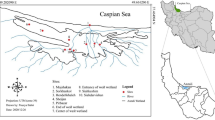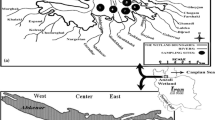Abstract
Wuyiling Nature Reserve is located at the edge of a frozen soil area and has abundant vegetation resources. It is an important area for evaluating the impact of frozen soil degradation on the environment. Analyzing the water quality and eutrophication characteristics of different swamps and water bodies can provide a basis for protecting the water environment of frozen soil areas. The pollution characteristics of different swamps and water bodies were analyzed and the Levenberg–Marquardt back-propagation neural network was used to evaluate water quality and eutrophication. Finally, the eutrophication evaluation was compared with the nutritional status index. The results demonstrated that (1) the highest concentrations of the total phosphorus (TP), total nitrogen, ammonia nitrogen (AN), permanganate index (PI), chemical oxygen demand, and chlorophyll were all present in the Tangwang River, which could be caused by the effects of human and agricultural activities along the river. The maximum average concentrations of TP, AN, and PI in the four wetland swamps appeared in the shrub swamp; (2) The water quality category of shrub, grass, and forest swamps in Wuyiling Nature Reserve was Class II, and the water quality category of floating swamps and the Tangwang River was Class I. The nutrient levels of the four marsh swamp wetlands and the Tangwang River were in the mid-range for many nutrients; and (3) the LM–BP neural network model, which was used to evaluate water eutrophication, and the results of a comprehensive evaluation of a nutritional status index were similar, further demonstrating the credibility of the evaluation results.





Similar content being viewed by others
References
Anthony F, Olivier E, Sylvain H et al (2020) Regional trends in eutrophication across the Loire river basin during the 20th century based on multi-proxy paleolimnological reconstructions. Agric Ecosyst Environ 301:107065
Asgher MS, Sharma S, Singh R, Singh D (2021) Assessing human interactions and sustainability of Wetlands in Jammu, India using Geospatial technique. Model Earth Syst Environ
Broeck MVD, Waterkeyn A, Rhazi L, Grillas P, Brendonck L (2015) Assessing the ecological integrity of endorheic wetlands, with focus on mediterranean temporary ponds. Ecol Ind 54:1–11
Chang CL, Yu ZE (2020) Application of water quality model to analyze pollution hotspots and the impact on reservoir eutrophication. Environ Monit Assess 192:495
Deng D, Liu G, Li X et al (2007) A comprehensive evaluation model for lake and reservoir eutrophication based on simple integration of neural networks. Acta Ecol Sin 27(2):725–731
Elliott KS, John WD et al (2020) Release of geogenic uranium and arsenic results in water-quality impacts in a subarctic permafrost region of granitic and metamorphic geology. J Geochem Explor 217:106607
Feng S, Xu S, Zhang X et al (2018) Myriophyllum aquaticum-based surface flow constructed wetlands for enhanced eutrophic nutrient removal—a case Study from laboratory-scale up to pilot-scale constructed wetland. Water 10:1391
Grogan P, Michelsen A, Ambus P, Jonasson S (2004) Freeze-thaw regime effects on carbon and nitrogen dynamics in sub-arctic heath tundra mesocosms. Soil Biol Biochem 36:641–654
Guildford SJ, Hecky RE (2000) Total nitrogen, total phosphorus, and nutrient limitation in lakes and oceans: is there a common relationship? Limnol Oceanogr 45(6):1213–1223
He F (2010) Implementation of comprehensive evaluation method MATLAB. Social Science Press, Beijing
Janssen ABG, de Jager VCL, Janse JH, Kong XZ, Liu SE, Ye QH et al (2017) Spatial identification of critical nutrient loads of large shallow lakes: implications for Lake Taihu (China). Water Res 119:276–287
Jasmina MV, Derek KG et al (2020) Changes in water quality related to permafrost thaw may significantly impact zooplankton in small Arctic lakes. Ecol Appl 30(8):e02186
Li R, Chen H, Liu C, He R (2020a) Water quality characteristics and environmental quality assessment of landscape water bodies in Hefei City Ring Park. Acta Sci Circum 40(3):1121–1129
Li W, Dou Z, Cui L et al (2020b) Soil fauna diversity at different stages of reed restoration in a lakeshore wetland at Lake Taihu, China. Ecosyst Health Sustain 6(1):1722034
Lindsay ES, Xing F et al (2019) Modelling the effects of permafrost loss on discharge from a wetland-dominated, discontinuous permafrost basin. Hydrol Process 33:2607–2626
Mao D, Wang Z, Li L (2014) Quantitative assessment of human-induced impacts on marshes in Northeast China from 2000 to 2011. Ecol Eng 68:97–104
Marion C, John M et al (2019) Groundwater hydrogeochemistry in permafrost regions. Permafrost Periglac Process 30:90–103
Murphy AE, Sageman BB, Hollander DJ (2000) Eutrophication by decoupling of the marine biogeochemical cycles of C, N, and P: a mechanism for the Late Devonian mass extinction. Geology 28:427–430
Nicholas J et al (2015) Water quality in two Icelandic rivers: the influence of impoundment, agriculture, glaciation and permafrost. Hydrol Res 46(3):429–445
Pearl HW, Huisman J (2008) Blooms like it hot. Science 20:57–58
Shao H, Chen H, Yang Y et al (2008) Application of principal component analysis and cluster analysis to evaluate the quality difference of flue-cured tobacco leaves. J Southwest Agric Sci 06:1559–1563
Sharma S, Szele Z, Schilling R, Munch JC, Schloter M (2006) Influence of freezethaw stress on the structure and function of microbial communities and denitrifying populations in soil. Appl Environ Microbiol 72:2148–2154
Shen X, Xue Z, Jiang M et al (2019) Spatiotemporal change of vegetation coverage and its relationship with climate change in freshwater marshes of Northeast China. Wetlands 39(3):429–439
Song L, Yao Y, Lin L et al (2019) The potential source of nitrous oxide in the pristine riparian marsh during freeze-thaw cycles, case study in Northeast China. Ecol Eng 134:18–25
Wahlstrom I, Hoglund A, Almroth-Rosell E et al (2020) Combined climate change and nutrient load impacts on future habitats and eutrophication indicators in a eutrophic coastal sea. Limnol Oceanogr 65:2170–2187
Wang J, Wang L, Zhan W et al (2015) TPLP model: the principle and application of a lake and reservoir eutrophication evaluation model. China Popul Resourc Environ 1:180–183
Wang SL, Li JS, Evangelos S (2018) Trophic state assessment of global inland waters using a MODIS-derived Forel-Ule index. Remote Sens Environ 217:444–460
Wei Z, Jin H, Zhang J et al (2011) Prediction of permafrost changes in Northeast China under climate change. Sci China 041(001):74–84
Xiao C, Wang S, Qin D (2016) The service function of cryosphere and its value evaluation. Climate Change Res Prog 012(001):45–52
Xie P, Chen H, Tang T, Li B, Lei X, Zhang B (2015) Truth-number weighting method for lake eutrophication combination evaluation. J Environ Sci 35(9):2910–2915
Xu YJ (2013) Transport and retention of nitrogen, phosphorus and carbon in North America’s Largest River Swamp Basin, the Atchafalaya River Basin. Water 5:379–393
Yang Y, Wang Q, Xiao Q (2007) Evaluation of Taihu Lake Eutrophication by Remote Sensing. Geogr Geo-Inf Sci 3:33–37
Yang J, Andreas H, Andre W et al (2020) Identifying spatio-temporal dynamics of trace metals in shallow eutrophic lakes on the basis of a case study in Lake Taihu, China. Environ Pollut 264:114802
Zhang Y, Li MX et al (2021) A critical review of methods for analyzing freshwater eutrophication. Water 13:225
Acknowledgements
This work was supported by National Natural Science Foundation of China (Grant Nos. 42071079, 41671100).
Author information
Authors and Affiliations
Corresponding author
Additional information
Publisher's Note
Springer Nature remains neutral with regard to jurisdictional claims in published maps and institutional affiliations.
Rights and permissions
About this article
Cite this article
Che, L., Wan, L. Water Quality Analysis and Evaluation of Eutrophication in a Swamp Wetland in the Permafrost Region of the Lesser Khingan Mountains, China. Bull Environ Contam Toxicol 108, 234–242 (2022). https://doi.org/10.1007/s00128-021-03359-5
Received:
Accepted:
Published:
Issue Date:
DOI: https://doi.org/10.1007/s00128-021-03359-5




